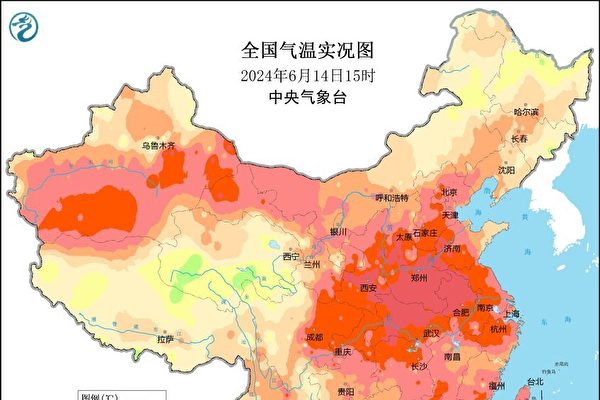During the “Sanxia” period (summer harvest, summer planting, summer management) in China, the weather conditions are extremely unusual in various regions. Eight provinces including Hunan are experiencing heavy rainfall, while eleven provinces including Henan are facing high temperatures and drought, affecting nearly 300 million people. Henan, known as a major grain-producing region in China, is expected to face over a month of low rainfall and drought.
On June 14th, the China Meteorological Administration issued weather forecasts for rainfall, high temperatures, and severe convective weather. According to the report, regions such as Hunan, Jiangxi, Fujian, Zhejiang, Guangxi, Guangdong, Yunnan, and Guizhou are seeing heavy rain, thunderstorms, or torrential rain. Areas in Heilongjiang, Jilin, Liaoning, Hebei, and Shandong are experiencing heavy rain or thunderstorms.
Furthermore, regions in Shaanxi, Shanxi, Hebei, Shandong, Henan, Anhui, Jiangsu, Hubei, Sichuan, Chongqing, and Hunan are facing high temperatures. Henan and Hubei have recorded daily maximum temperatures exceeding the June extreme values.
According to the China Meteorological Administration, some areas in Shanxi, Shaanxi, Henan, Hebei, and Shandong have surface temperatures exceeding 60°C in the afternoon, some even reaching above 70°C.
Zhai Jianqing, a researcher from the Meteorological Disaster Risk Management Office of the China Climate Center, pointed out that in Hebei, Shandong, and Tianjin, 42 national meteorological stations have reached extreme high-temperature thresholds, with 86 stations recording daily maximum temperatures exceeding 40°C. The high-temperature impacts cover an area of approximately 500,000 square kilometers, affecting around 290 million people.
Since late April, the average temperature in Henan Province has been 1.8°C higher than the same period in previous years, representing the second-highest value since 1961. The average precipitation during the same period has been 71% lower than normal.
Reports from meteorologists indicate that currently, over 60% of the soil in Henan Province is experiencing drought, with most parts lacking moisture and deviation in the sowing meteorological conditions. Statistics show that the area unable to sow due to drought in the province exceeds 3 million mu.
Latest meteorological drought monitoring data shows that 72 national-level meteorological stations in 16 cities including Anyang, Hebi, Xuchang, Jiaozuo, Kaifeng, and Luoyang in Henan Province have reached severe drought or above levels, persisting for 10 days. Zhengzhou has issued continuous high-temperature red alerts since June 12th.
It is anticipated that the drought conditions in the aforementioned regions and surrounding areas will further expand until June 29th. Meteorological authorities predict that Henan may face over a month of low rainfall and drought.
Lü Juan, former director of the Flood Control, Drought Resistance, and Disaster Reduction Center at the China Institute of Water Resources and Hydropower Research, mentioned in an interview with The Paper on June 14th that the uneven distribution of precipitation in Henan Province often leads to localized drought disasters almost every year, with widespread, province-wide severe droughts occurring occasionally. She stated that severe drought disasters in history have hardly spared Henan. Lü Juan pointed out that this year’s drought situation in China exhibits characteristics of “unusual occurrence time, unusual drought features, and unusual development trends.”
This drought occurring during the critical period of summer planting season. Traditionally, the North China region mainly experiences spring droughts, but this year, the drought is concentrated during the “Sanxia” period, crucial for the annual agricultural cycle of planting, growing, and managing crops.
This year’s drought is characterized by widespread high temperatures and low rainfall, developing rapidly. Temperatures have been soaring across northern regions with continuous high temperatures and lack of rainfall, leading to over half of the meteorological monitoring stations reaching levels of moderate drought or above, with severe and extreme drought areas continually expanding.
Henan province is facing severe losses due to “rotten field rain,” leading to widespread germination and molding of wheat.
Heavy rainfall disasters have resulted in significant losses for wheat crops in Henan, with villagers complaining about inadequate compensation.
Concern has been raised as hundreds of harvesting machines were intercepted at toll stations in Henan.

